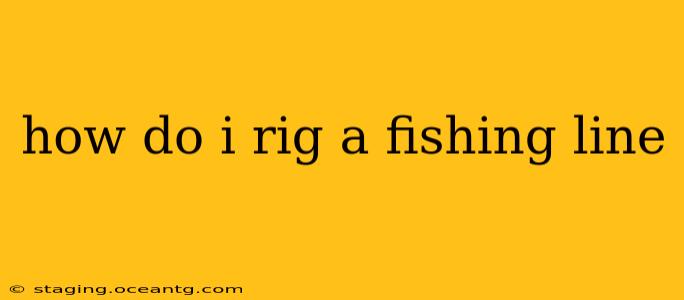How to Rig a Fishing Line: A Comprehensive Guide for Anglers of All Levels
Rigging your fishing line correctly is crucial for successful fishing. The right rig ensures your bait or lure presents itself attractively to the fish, while also providing the strength and sensitivity needed to hook and land your catch. This guide covers various rigging techniques, catering to beginners and experienced anglers alike.
Understanding the Basics: What You'll Need
Before diving into specific rigs, let's cover the essential components:
- Fishing Line: Choose the right line type (monofilament, fluorocarbon, braided) and strength based on the type of fish you're targeting and the fishing conditions.
- Hooks: Select hooks appropriate for your bait or lure and the size of fish you expect to catch.
- Swivels: These prevent line twist, especially important when using lures or spinners.
- Weights (Sinkers): Used to get your bait or lure down to the desired depth. Different types include split shot, bullet weights, and drop shot weights.
- Bobbers (Floats): Keep your bait suspended at a specific depth.
- Leaders: Often used with heavier lines to provide increased sensitivity and abrasion resistance. Fluorocarbon is a popular choice for leaders.
What are the different types of fishing line rigs?
There are countless fishing line rigs, each designed for specific fishing situations and target species. However, some fundamental rigs form the basis of many more complex setups. Let's explore a few:
1. Simple Hook Rig:
This is the most basic rig, ideal for beginners and many freshwater fishing applications. Simply tie your hook directly to the end of your fishing line. This is effective for using bait like worms, crickets, or small live fish.
2. Dropshot Rig:
This is a highly versatile and popular technique, especially for finesse fishing. A weight is tied to the end of the line, with the hook tied above it on a short length of line. This allows your bait to hang suspended, tempting fish to bite.
3. Texas Rig:
Frequently used for bass fishing with plastic worms, this rig involves inserting the hook point into the worm's head and covering the hook shank with the worm. A weight is then added to the line above the hook. This creates a weedless presentation, ideal for fishing in heavy cover.
4. Carolina Rig:
Similar to the Texas rig, but uses a longer leader between the weight and the hook. This rig allows the bait to move more freely, covering more water. It's effective for covering larger areas and fishing in deeper water.
5. Palomar Knot:
This is a strong and reliable knot used for attaching hooks and lures to your fishing line.
How do I choose the right fishing line for my rig?
The type of fishing line you choose significantly impacts your success. Consider these factors:
- Target Species: Larger fish require stronger lines.
- Fishing Location: Clear water often benefits from low-visibility lines like fluorocarbon. Weedy areas might require more abrasion-resistant lines.
- Fishing Technique: Certain techniques benefit from specific line types. For instance, braided lines excel at sensitive presentations due to their lack of stretch.
How do I prevent my fishing line from tangling?
Line tangles are a common frustration. Here are some tips to minimize them:
- Proper Storage: Store your line neatly on a spool.
- Careful Casting: Avoid casting in windy conditions or into heavy cover.
- Regular Line Checks: Inspect your line for knots or frays.
- Use swivels: As previously mentioned, swivels are crucial in preventing line twist, a major contributor to tangles, especially when using lures or spinners.
What are the common mistakes when rigging a fishing line?
Several common mistakes can hinder your fishing success. Be mindful of:
- Using the wrong type of hook for your bait or lure.
- Overtightening knots, potentially weakening the line.
- Not using a leader for situations requiring additional abrasion resistance.
- Not paying attention to the weight and sensitivity needed for your target depth and conditions.
By understanding the basics of fishing line rigs and avoiding common mistakes, you can significantly increase your chances of a successful fishing trip. Remember to experiment with different rigs and techniques to discover what works best for you and the fish you're targeting. Happy fishing!
